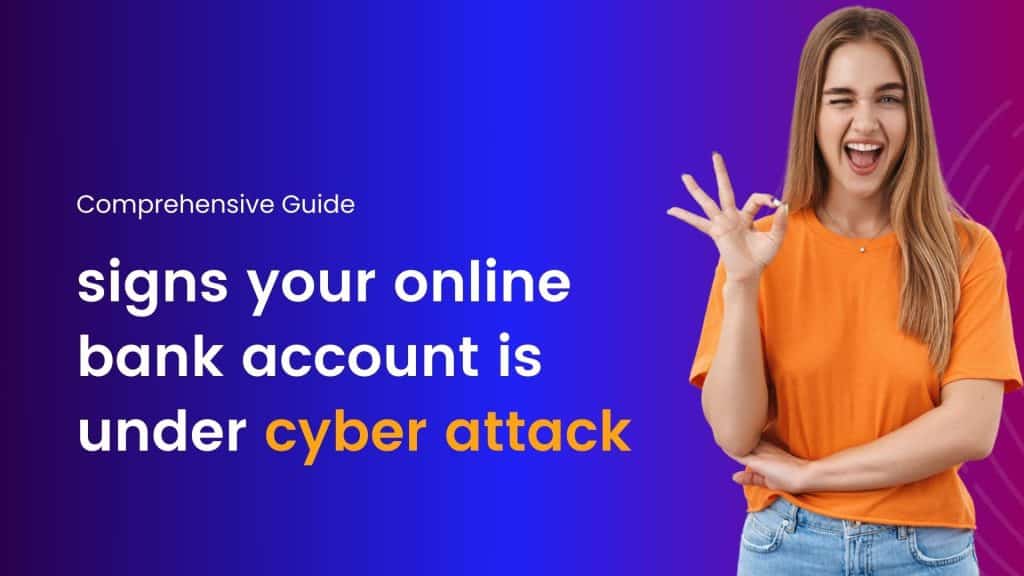In today’s digital age, online banking has become an essential part of our lives, offering convenience and ease of access. However, with this convenience comes the risk of cyber attacks. Cybercriminals are constantly devising new ways to breach online banking security. Being aware of the signs of a potential cyber attack can help you take swift action to protect your finances.
Here are some crucial indicators that your online bank account might be under attack
Unauthorized Transactions
One of the most obvious signs of a cyber attack is unauthorized transactions. If you notice any transactions that you did not initiate, it’s a red flag. Cybercriminals often start with small amounts to test if the account is being monitored before making larger withdrawals.
Suspicious Account Activity
Unusual account activity, such as multiple failed login attempts or logins from unfamiliar devices and locations, can indicate that someone is trying to gain access to your account. Most banks have systems in place to notify you of such activities, so pay attention to these alerts.
Unexpected Password Changes
If you receive a notification that your password has been changed without your knowledge, it’s a clear sign that someone else has gained access to your account. Cybercriminals often change passwords to lock you out of your account while they carry out fraudulent activities.
Unfamiliar Devices or IP Addresses
Banks often provide a history of devices and IP addresses used to access your account. If you notice any unfamiliar devices or IP addresses, it could mean that your account has been compromised. Regularly reviewing this information can help you detect unauthorized access early.
Decrease in Account Balance
A sudden and unexplained decrease in your account balance is a cause for concern. Cybercriminals might transfer funds to their accounts or use your money for fraudulent purchases. Regularly monitor your account balance and report any discrepancies immediately.
New Payees Added
If you notice new payees or beneficiaries added to your account that you did not authorize, it’s a sign that someone is trying to divert your funds. Verify all payee additions and ensure they were initiated by you.
Security Notifications from Your Bank
Banks have sophisticated systems in place to detect suspicious activities. If you receive security alerts or notifications from your bank about unusual activities or potential security breaches, take them seriously and follow the recommended actions.
Phishing Emails and Messages
Cyber attackers often use phishing emails and messages to trick you into revealing your login credentials. Be cautious of any emails or messages claiming to be from your bank that ask for personal information or direct you to a website that looks like your bank’s login page.
Changes in Personal Information
Unauthorized changes to your personal information, such as your email address, phone number, or physical address, can be an indication that your account has been compromised. Cybercriminals might change these details to intercept communication from your bank.
Inability to Access Your Account
If you are suddenly unable to access your online banking account with your usual credentials, it could mean that someone has gained access and changed your login details. Contact your bank immediately if you experience this issue.
Steps to Take if Your Account is Under Attack
In today’s digital age, online accounts are crucial for various aspects of our lives, from communication to financial transactions. Unfortunately, these accounts are also prime targets for cyberattacks. If you suspect that your account is under attack, it’s essential to act swiftly and decisively to mitigate any potential damage. Here are the steps you should take if your account is compromised:
Recognize the Signs of an Attack
Before taking any action, ensure that your account is indeed under attack. Common signs include:
- Unexpected login attempts or notifications from unfamiliar locations or devices.
- Unauthorized changes to account information, such as password, email address, or phone number.
- Unusual activity, such as messages or posts you didn’t create, or transactions you didn’t authorize.
- Receiving security alerts from the service provider indicating suspicious activity.
Change Your Password Immediately
As soon as you suspect your account is compromised, change your password. Ensure the new password is strong and unique:
- Use a combination of uppercase and lowercase letters, numbers, and special characters.
- Avoid using easily guessable information, such as your name, birthdate, or common words.
- Use a password manager to generate and store complex passwords securely.
Enable Two-Factor Authentication (2FA)
Two-factor authentication adds an extra layer of security to your account by requiring a second form of verification in addition to your password. This could be a text message code, an authentication app, or a biometric factor like a fingerprint or facial recognition. Enabling 2FA can prevent unauthorized access even if your password is compromised.
Review Account Activity
Check your account’s recent activity to identify any unauthorized actions. Look for:
- Login attempts from unfamiliar locations or devices.
- Changes to account settings or security information.
- Suspicious transactions or messages.
Revoke Unauthorized Access
If the service allows it, review and revoke access to any unfamiliar devices or third-party applications linked to your account. This step can prevent attackers from continuing to access your account using authorized devices or apps.
Update Security Questions and Backup Options
If your account uses security questions or backup email addresses for recovery purposes, update these as well. Ensure that the answers to your security questions are not easily guessable or available through social media or public records.
Contact the Service Provider
Report the incident to the service provider’s support team. They can offer additional assistance, such as restoring your account, investigating the breach, and providing guidance on further securing your account. Many providers have dedicated support channels for security-related issues.
Monitor Your Other Accounts
If you use the same password or similar security information across multiple accounts, it’s crucial to update those passwords and secure those accounts as well. Cyber attackers often attempt to use compromised credentials across various services.
Be Wary of Phishing Attempts
Attackers may try to gain further access by sending phishing emails or messages designed to trick you into providing additional information. Be cautious of any suspicious communications and verify the authenticity of any requests for sensitive information.
Educate Yourself on Cybersecurity
Understanding cybersecurity best practices can help you prevent future attacks. Stay informed about common threats, such as phishing, malware, and social engineering, and learn how to recognize and respond to them.
What Should I Do Immediately If I Suspect My Bank Account Is Under Attack?
In today’s digital age, the security of our bank accounts is paramount. Cybercriminals are constantly devising new ways to infiltrate financial systems and steal personal information. If you suspect your bank account is under attack, it is crucial to act swiftly and decisively to minimize potential damage. Here is a comprehensive guide on what steps to take immediately:
Stay Calm and Assess the Situation
Panicking can lead to hasty decisions. Take a deep breath and try to gather as much information as possible. Look for any unauthorized transactions, unfamiliar login alerts, or suspicious emails and messages related to your bank account.
Secure Your Account
- Change Your Passwords: Immediately change your online banking password and any associated email passwords. Choose a strong, unique password that combines letters, numbers, and special characters.
- Enable Two-Factor Authentication (2FA): If your bank offers 2FA, enable it right away. This adds an extra layer of security by requiring a second form of verification (like a text message code) in addition to your password.
Contact Your Bank
- Report the Suspicious Activity: Contact your bank’s fraud department or customer service as soon as possible. Most banks have 24/7 support for reporting fraud. Provide them with all the details of the suspicious activity.
- Freeze Your Account: Request a temporary freeze on your account to prevent further unauthorized transactions while the bank investigates.
- Follow Up: Ask for a reference number for your report and follow up with the bank regularly to stay updated on the status of your case.
Review Recent Transactions
Go through your recent account statements and transaction history meticulously. Note any unauthorized transactions and report them to your bank. This will help the bank in their investigation and may be necessary for disputing fraudulent charges.
Check Other Financial Accounts
If your bank account is compromised, other financial accounts (credit cards, investment accounts, etc.) may also be at risk. Review these accounts for any suspicious activity and take similar protective measures if necessary.
Update Security Software
Ensure that your computer, smartphone, and other devices have up-to-date security software. Run a full system scan to check for malware or other security threats that could have compromised your account.
Notify Credit Bureaus
Contact major credit bureaus (Equifax, Experian, and TransUnion) to place a fraud alert on your credit report. This alert notifies creditors to take extra steps to verify your identity before opening new accounts in your name.
Consider a Credit Freeze
A credit freeze restricts access to your credit report, making it more difficult for identity thieves to open new accounts in your name. You can lift the freeze temporarily when you need to apply for credit.
File a Police Report
If you have identified unauthorized transactions or believe your identity has been stolen, file a report with your local police department. This report can be useful when dealing with creditors and financial institutions.
Monitor Your Accounts Regularly
Vigilance is key to preventing future attacks. Regularly monitor your bank statements, credit reports, and account activity. Set up account alerts to notify you of any unusual activity.
Educate Yourself on Phishing Scams
Phishing scams are a common method cybercriminals use to gain access to bank accounts. Be cautious of emails, texts, or phone calls asking for personal information. Always verify the source before clicking on links or providing sensitive information.
Steps to Take if Your Account is Compromised
Here’s a table outlining the steps to take if your account is compromised:
| Step | Action | Details |
|---|---|---|
| Identify the Compromise | Monitor for unusual activity | Check for unauthorized transactions, login attempts, or changes to account settings. |
| Secure Your Device | Run antivirus and malware scans | Ensure your device is free from any malware that may have caused the compromise. |
| Change Passwords | Update passwords for compromised and related accounts | Use strong, unique passwords and avoid reusing passwords across multiple sites. Consider using a password manager. |
| Enable 2FA | Activate two-factor authentication (2FA) on all accounts | Adds an extra layer of security to prevent unauthorized access. |
| Notify Relevant Parties | Inform your bank, credit card companies, and other relevant institutions | Prevent further unauthorized transactions and receive guidance on protecting your accounts. |
| Review Account Settings | Check and update account security settings | Ensure recovery options are accurate and consider adding extra security measures. |
| Monitor Accounts | Keep an eye on your accounts for further suspicious activity | Regularly check statements and account activity. |
| Report to Authorities | File a report with relevant authorities and institutions | Contact local law enforcement and report the compromise to the Federal Trade Commission (FTC) or equivalent agency in your country. |
| Inform Contacts | Notify friends, family, and contacts of the compromise | Warn them about potential phishing attempts or unusual messages coming from your compromised account. |
| Educate Yourself | Learn about security best practices to prevent future compromises | Stay informed about common cyber threats and ways to protect your personal information. |
| Consider Credit Freeze | Place a credit freeze or fraud alert on your credit report if financial information is involved | Prevents new accounts from being opened in your name without your knowledge. |
| Backup Data | Regularly back up important data | Protects against data loss from future compromises or other issues. |
| Contact Support | Reach out to the compromised account’s support team | They can help recover your account and provide additional security recommendations. |
These steps can help mitigate the damage and secure your accounts after a compromise.
Regulatory Bodies and Resources
In an increasingly digital world, the security of your bank account is paramount. Despite advancements in cybersecurity, bank account compromises remain a significant concern. If your account is compromised, understanding the legal protections available and knowing which regulatory bodies and resources to turn to can help you navigate the situation effectively.
Understanding Bank Account Compromise
A compromised bank account can result from various activities, including unauthorized access, identity theft, phishing schemes, or data breaches. The consequences can be severe, leading to unauthorized transactions, financial loss, and damage to your credit rating.
Key Regulatory Bodies
Several regulatory bodies oversee financial institutions and ensure consumer protection. Knowing these bodies and their roles can help you understand where to seek assistance if your account is compromised.
Federal Deposit Insurance Corporation (FDIC)
-
- Role: Insures deposits at banks and savings institutions.
- Protection: If a bank fails, the FDIC protects depositors by insuring their deposits up to the insured limit.
- Resource: FDIC Consumer Assistance
Office of the Comptroller of the Currency (OCC)
-
- Role: Regulates and supervises national banks and federal savings associations.
- Protection: Ensures that banks operate safely and soundly, provides consumer protection, and enforces anti-money laundering laws.
- Resource: OCC Consumer Protection
Consumer Financial Protection Bureau (CFPB)
-
- Role: Ensures consumers are treated fairly by banks, lenders, and other financial institutions.
- Protection: Handles consumer complaints, enforces consumer protection laws, and educates consumers on financial products.
- Resource: CFPB Complaints
Federal Trade Commission (FTC)
-
- Role: Protects consumers from deceptive practices.
- Protection: Provides resources for identity theft recovery and educates consumers on avoiding fraud.
- Resource: IdentityTheft.gov
Financial Crimes Enforcement Network (FinCEN)
-
- Role: Oversees the enforcement of anti-money laundering laws.
- Protection: Works to prevent and punish financial crimes, including bank fraud and identity theft.
- Resource: FinCEN Resources
Legal Protections
Having your bank account compromised can be a stressful and potentially devastating experience. However, various legal protections are in place to help you recover from such incidents. These protections vary by jurisdiction, but in many countries, several key measures provide a safety net for account holders. Below is a comprehensive overview of the legal protections you may have if your bank account is compromised.
When your bank account is compromised, several legal protections are in place to help you recover your funds and protect your rights.
Bank Policies
Individual banks may offer additional protections through their policies. These can include:
Zero Liability Policies
Zero liability policies are typically offered by banks and credit card companies to protect consumers from unauthorized transactions. These policies ensure that customers are not held responsible for fraudulent charges made to their accounts. Here are some key points about these policies:
Zero Liability Policy for Credit Cards:
-
- Under these policies, cardholders are not liable for unauthorized charges.
- Cardholders must promptly report any suspicious or fraudulent activity.
- The cardholder’s account must be in good standing.
Zero Liability Policy for Debit Cards:
-
- Similar to credit cards, but the timing of the reporting can affect the consumer’s liability.
- For instance, if a cardholder reports the loss or theft of a debit card within two business days, their liability is limited to $50. After two business days, their liability could increase.
- The exact terms can vary by bank, so it’s important to review the specific policy of your bank.
Conditions and Limitations:
-
- Banks may have specific conditions, such as requiring timely reporting of unauthorized transactions.
- There may be exclusions, such as transactions involving negligence by the cardholder (e.g., sharing PIN or account details).
- Coverage may not extend to business accounts or certain types of transactions.
Consumer Protection Laws:
-
- In the U.S., federal laws like the Fair Credit Billing Act (FCBA) and the Electronic Fund Transfer Act (EFTA) provide foundational protections for credit and debit card users, respectively.
These laws set the maximum liability limits and stipulate timelines for reporting fraud.
How to Protect Yourself:
-
-
- Regularly monitor account statements and transactions.
- Report lost or stolen cards immediately.
- Use secure passwords and PINs.
- Take advantage of account alerts and notifications.
-
By understanding and utilizing zero liability policies, consumers can better protect themselves against the financial impacts of fraud and unauthorized transactions.
Fraud Detection Services
Banks often provide fraud detection services that monitor your account for suspicious activity and alert you immediately.
Credit Card Protections
Credit card protections refer to various features and safeguards provided by credit card companies to help protect cardholders from fraud, unauthorized transactions, and other potential issues. These protections can offer peace of mind and financial security. Here are some key types of credit card protections:
Fraud Protection:
-
- Zero Liability Policy: Cardholders are not held responsible for unauthorized transactions if they report them promptly.
- Fraud Monitoring: Credit card companies monitor accounts for unusual activity and may alert cardholders to potential fraud.
Purchase Protection:
-
- Extended Warranty: Extends the manufacturer’s warranty on purchased items for an additional period.
- Purchase Security: Covers eligible items against damage or theft for a certain period after purchase.
Price Protection:
-
- If an item purchased with the credit card is found at a lower price within a specified period, the difference may be refunded.
Return Protection:
-
- Allows cardholders to return eligible items within a specified period, even if the retailer’s return policy does not accept the return.
Travel Protections:
-
- Travel Insurance: Covers trip cancellations, interruptions, or delays.
- Lost Luggage Insurance: Reimburses costs if luggage is lost or delayed.
- Travel Accident Insurance: Provides coverage in case of an accident during travel.
Rental Car Insurance:
-
- Provides coverage for damage or theft of rental cars, often supplementing personal auto insurance policies.
Cell Phone Protection:
-
- Covers damage or theft of cell phones purchased with the credit card, often requiring the cardholder to pay the monthly bill with the card.
Identity Theft Protection:
-
- Provides services to help cardholders recover their identity if it’s stolen, including assistance with paperwork and contacting relevant institutions.
Dispute Resolution:
-
- Assists cardholders in resolving disputes with merchants, such as receiving defective goods or not receiving purchased items.
These protections can vary significantly between credit card issuers and specific card types, so it’s important to review the terms and conditions of your card to understand the exact protections offered.
Credit card protections vary by issuer and card type, but generally, they offer a range of benefits to help safeguard cardholders. Here’s a table summarizing common credit card protections:
| Protection Type | Description | Common Issuers |
|---|---|---|
| Fraud Protection | Protects against unauthorized charges. Most issuers offer zero liability for fraudulent transactions. | Visa, Mastercard, American Express, Discover |
| Purchase Protection | Covers new purchases against damage or theft for a limited period, usually 90-120 days. | American Express, Visa, Mastercard |
| Extended Warranty | Extends the manufacturer’s warranty on eligible items, typically by 1 year. | American Express, Visa, Mastercard |
| Return Protection | Allows returns on eligible items even if the store won’t accept them, within a specified period (e.g., 90 days). | American Express, Mastercard |
| Price Protection | Refunds the difference if you find a lower price on an eligible item within a certain period after purchase. | Mastercard, Citi |
| Travel Insurance | Includes trip cancellation/interruption insurance, travel accident insurance, and baggage delay/loss coverage. | Chase, American Express, Citi |
| Rental Car Insurance | Provides coverage for rental car damage or theft. This can be primary or secondary coverage. | Chase, American Express, Visa |
| Roadside Assistance | Offers help in case of car trouble, such as towing or jump-starts. | Visa, Mastercard, American Express |
| Cell Phone Protection | Covers damage or theft of cell phones when the bill is paid with the credit card. | Wells Fargo, Chase, U.S. Bank |
| Identity Theft Protection | Offers services to help monitor and resolve identity theft issues. | Discover, American Express, Capital One |
Each credit card issuer has specific terms and conditions for these protections, so it’s important to review the details provided by your credit card company.
Electronic Fund Transfer Act (EFTA)
-
- Scope: Covers electronic transactions involving consumers, including ATMs, debit cards, and direct deposits.
- Protection: Limits your liability for unauthorized transactions. If you report a lost or stolen card within two business days, your liability is capped at $50. If you report within 60 days, your liability is limited to $500. Beyond 60 days, you could be responsible for all unauthorized transactions.
- Resource: EFTA Consumer Rights
Truth in Lending Act (TILA)
-
- Scope: Applies to credit card transactions.
- Protection: Limits your liability for unauthorized credit card charges to $50.
- Resource: TILA Overview
Bank Secrecy Act (BSA)
-
- Scope: Requires financial institutions to assist in the detection and prevention of money laundering.
- Protection: Ensures banks implement anti-money laundering measures, making it more challenging for criminals to compromise accounts.
- Resource: BSA Information
Fair Credit Billing Act (FCBA)
-
- Scope: Provides protections against billing errors on credit card accounts.
- Protection: Allows consumers to dispute fraudulent charges and temporarily withhold payment on those charges during the investigation.
- Resource: FCBA Rights
“These calls to action provide clear and actionable steps for individuals who suspect their online bank account is under cyber attack, emphasizing the importance of quick response and proactive security measures. Sign Up Hostao Today“
Conclusion
Being vigilant and proactive is crucial in protecting your online bank account from cyber attacks. By recognizing the signs of a potential breach and taking immediate action, you can minimize the risk and safeguard your financial assets. Regularly updating your security measures and staying informed about the latest cyber threats will help you stay one step ahead of cybercriminals.
Having your account compromised can be a stressful and unsettling experience, but taking immediate and informed action can help mitigate the damage and restore your security. By following these steps, you can protect your personal information, regain control of your account, and reduce the risk of future attacks. Always remain vigilant and proactive about your online security to safeguard your digital presence.
Suspecting that your bank account is under attack can be a daunting experience, but taking immediate and decisive action can help mitigate the damage. By staying calm, securing your account, contacting your bank, and following the steps outlined above, you can protect your financial assets and personal information from further harm. Always remain vigilant and proactive in safeguarding your accounts to prevent future incidents.
While having your bank account compromised is a serious issue, numerous legal protections exist to help you recover your funds and secure your account. Federal and state laws, combined with bank policies and regulatory resources, provide a robust framework to support consumers in such situations. By acting quickly and utilizing available resources, you can mitigate the impact of unauthorized transactions and regain control of your finances.
I'm a tech-savvy writer with a Computer Science degree and web hosting background, contributing to Hostao Blogs. I simplify complex tech topics like web development and cybersecurity. Beyond writing, I'm a tech explorer passionate about digital advancements.




















